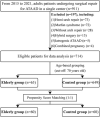Septuagenarians with acute type A aortic dissection undergoing extended aortic arch repair: a retrospective cohort study
- PMID: 37226875
- PMCID: PMC10389339
- DOI: 10.1097/JS9.0000000000000342
Septuagenarians with acute type A aortic dissection undergoing extended aortic arch repair: a retrospective cohort study
Abstract
Background: Extended arch repair in elderly patients with acute type A aortic dissection (ATAAD) remains challenging for cardiac surgeons. Data on extended arch repair for ATAAD in septuagenarians are scarce.
Materials and methods: Consecutive adult patients with ATAAD undergoing extended arch repair from January 2015 to December 2021 were identified. According to age at presentation, 714 eligible patients were entered into either an elderly group (septuagenarians, n =65) or a control group (patients aged less than 70, n =649). Using propensity score matching, 60 pairs of patients were successfully established at a 1:1 ratio. In-hospital outcomes (operative death and major postoperative morbidity) and midterm outcomes (survival and aortic reintervention) were compared before and after matching.
Results: Operative death occurred in 64 patients (9.0%), including seven septuagenarians (10.8%) and 57 (8.8%) from the control group, without significant differences between groups before and after matching ( P =0.593 and 0.774, respectively). Major postoperative morbidity was observed in 298 patients (41.7%), including 29 (44.6%) in the elderly group and 269 (41.4%) in the control group ( P =0.622). Age-based grouping was not significantly associated with operative mortality or major postoperative morbidity in the crude, multivariable, and propensity score analyses. The 5-year cumulative survival and cumulative aortic reintervention rates in the elderly group were 83.5 and 4.6%, respectively, which were not statistically different from those in the control group before and after matching.
Conclusions: Extended arch repair may be safely and effectively performed in septuagenarians with ATAAD, with in-hospital and midterm outcomes comparable to those obtained in patients aged less than 70 years.
Copyright © 2023 The Author(s). Published by Wolters Kluwer Health, Inc.
Conflict of interest statement
All authors declare that the research was conducted in the absence of any commercial or financial relationships that could be construed as a potential conflict of interest.
Sponsorships or competing interests that may be relevant to content are disclosed at the end of this article.
Figures






Similar articles
-
The outcomes of aortic arch repair between open surgical repair and debranching endovascular hybrid surgical repair: A systematic review and meta-analysis.J Vasc Surg. 2024 Jun;79(6):1510-1524. doi: 10.1016/j.jvs.2023.12.025. Epub 2023 Dec 18. J Vasc Surg. 2024. PMID: 38122857
-
Duplex ultrasound-based comparative analysis of inner branch orientation for the left common carotid artery following triple-branch arch endovascular repair.J Vasc Surg. 2025 Aug;82(2):409-420. doi: 10.1016/j.jvs.2025.04.062. Epub 2025 May 5. J Vasc Surg. 2025. PMID: 40334874
-
Early Thoracic Endovascular Aortic Repair for Acute Type B Dissection Is Associated with Increased Complications: Results from the Gore Global Registry for Endovascular Aortic Treatment Registry.Ann Vasc Surg. 2025 Sep;118:1-10. doi: 10.1016/j.avsg.2025.03.020. Epub 2025 Apr 13. Ann Vasc Surg. 2025. PMID: 40233894
-
Classification and outcomes of extended arch repair for acute Type A aortic dissection: a systematic review and meta-analysis.Interact Cardiovasc Thorac Surg. 2017 Mar 1;24(3):450-459. doi: 10.1093/icvts/ivw355. Interact Cardiovasc Thorac Surg. 2017. PMID: 28040765
-
The Use of the Ascyrus Medical Dissection Stent in Acute Type A Aortic Dissection Repair Reduces Distal Anastomotic New Entry Tear.Can J Cardiol. 2024 Mar;40(3):470-475. doi: 10.1016/j.cjca.2023.09.034. Epub 2023 Oct 13. Can J Cardiol. 2024. PMID: 37839655
Cited by
-
Efficacy and safety of laparoscopic bariatric surgery in patients of 70 years and older: A systematic review and meta-analysis.Obes Rev. 2025 Mar;26(3):e13867. doi: 10.1111/obr.13867. Epub 2024 Nov 17. Obes Rev. 2025. PMID: 39552151 Free PMC article.
-
Protective Effect on Spinal Cord Injury of Prophylactic Cerebrospinal Fluid Drainage in Extensive Aortic Arch Repair for Type A Aortic Dissection: A Retrospective Cohort Study.J Am Heart Assoc. 2025 Mar 4;14(5):e039427. doi: 10.1161/JAHA.124.039427. Epub 2025 Feb 26. J Am Heart Assoc. 2025. PMID: 40008544 Free PMC article.
-
ACE2 deficiency inhibits thoracic aortic dissection by enhancing SIRT3 mediated inhibition of inflammation and VSCMs phenotypic switch.Mol Med. 2024 Sep 19;30(1):154. doi: 10.1186/s10020-024-00926-4. Mol Med. 2024. PMID: 39300372 Free PMC article.
References
-
- Ikeno Y, Yokawa K, Yamanaka K, et al. . Total arch replacement in octogenarians and nonagenarians: a single-center 18-year experience. J Thorac Cardiovasc Surg 2020;160:346–56 e341. - PubMed
-
- Hata M, Sezai A, Niino T, et al. . Should emergency surgical intervention be performed for an octogenarian with type A acute aortic dissection? J Thorac Cardiovasc Surg 2008;135:1042–1046. - PubMed
-
- Beckmann E, Martens A, Kaufeld T, et al. . Is total aortic arch replacement with the frozen elephant trunk procedure reasonable in elderly patients? Eur J Cardiothorac Surg 2021;60:131–137. - PubMed
-
- Mehta RH, O’Gara PT, Bossone E, et al. . Acute type A aortic dissection in the elderly: clinical characteristics, management, and outcomes in the current era. J Am Coll Cardiol 2002;40:685–692. - PubMed
MeSH terms
LinkOut - more resources
Full Text Sources

